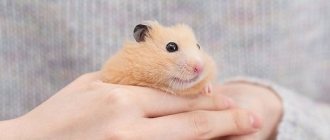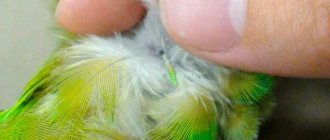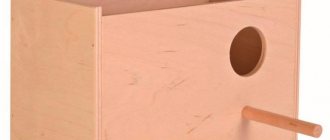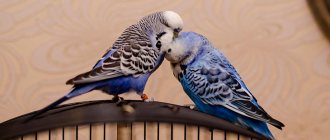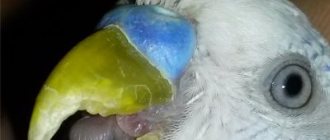It happens that a person who wants to purchase a feathered pet does not know how to determine the gender of a budgie. And some unscrupulous or incompetent sellers may sell a bird of the wrong sex. Everything would be fine, but when a person already has a feathered friend at home and takes a second one to create a pair, breed, this is where problems arise, because he may not have offspring. How to correctly determine the gender of a budgie, and what methods exist? Let's try to figure it out.
Why determine the sex of a budgie?
A cute chick will eventually become a bright and talkative bird. But how “colorful” his outfit will be, and whether he can easily learn to repeat words and phrases depends on gender. In nature, boy budgies attract the favorable attention of feathered ladies with the splendor of their coloring and wonderful singing. The not so elegant female budgies have completely different tasks: giving birth and hatching chicks, and coloring is not so important for them.
You need to know the sex of the bird if you want to buy a pair for breeding, take two parrots so that they don’t get bored, and when you want to teach your pet to speak.
How to determine the sex of an adult budgie and distinguish a male from a female?
I’ll say right away that with sex determination in adults, everything is much simpler, since parrots usually have obvious differences here. We will call adults those birds that have completed puberty, that is, sexually mature budgerigars. It is believed that these wavy animals are already three or four months old . To determine the sex of parrots that have reached sexual maturity, it is enough to know only 2 colors of waxes and understand who has which color. These colors are clearly different from each other. So, using this information, you can easily distinguish a male from a female.
Who is in front of you: he or she?
Will budgies be talkative and how to distinguish a boy from a girl can be determined by the behavior of the bird .
- The male is the leader, he must be noticeable and stand out not only in color. Under natural conditions, the activity of a bird determines its lifespan and attractiveness to the opposite sex.
An active, noisy and curious “boy” sings louder and more willingly, and enjoys showing off in front of the mirror and his relatives. He pesters other birds, trying to build hierarchical relationships. An active and brave budgerigar boy will bravely step into your hand for food and quickly get used to his new environment.
- And the girl is patient and restrained. She rarely raises her voice, and does not waste time acting in front of the mirror. The female prefers to quietly contemplate.
But if a parrot gets into a new home, she begins to adapt it to herself: she does “spring cleaning” and throws out everything unnecessary from the cage. Girl budgies do not speak as readily as males, but their speech is clearer.
How to recognize gender by behavior?
The behavior of cockatiels can be distinguished when they reach three months of age. At this age, boys begin to demonstrate their vocal abilities, although they only develop the urge to sing for a couple of weeks. Further, until six months of age, it will again be difficult to determine the sex of birds. It is customary for breeders to mark those who have a tendency to sing at the age of three months, so that in the future they will know that these are males.
Next, you should pay attention to the sociability of the bird. Males are usually more active than females; they like to “talk” with the owner, check various surfaces with their beak, and play
The fact that the cockatiel is a boy can be indicated by his strange jumps and the habit of folding his wings in the shape of a heart. Girls are calm and prefer sleep and relaxation to games.
When all individuals begin to sing, boys can be distinguished by the absence of sharp screaming roulades
It doesn’t matter whether the male learns special sounds or not, his voice will still be softer, more pleasant, his singing will be more whistling, unlike the voice of females, who prefer to produce more quiet and creaking sounds
If the bird became interested in the reflection and began to spend a lot of time near the new toy, communicating with a new “acquaintance,” then most likely it is a boy. An animal that quickly loses interest in its reflection is probably female. If there are two birds in a cage and their sex is unknown, then you can distinguish the boy during his courtship. During this period, the “in love” guy will behave as follows:
clicks its beak noisily to attract the attention of its beloved; walks back and forth, makes whistling sounds, continues clicking its beak, actively jumps, suddenly bends its head; shows his wings and folds them so that a heart is formed at the back.
The behavior of females during the mating season can also indicate gender
While the male goes out of his way to attract the attention of his lady, his partner behaves like this:
sits on a perch located as low as possible, raising his tail and whistling quietly; may offer food to the male who has attracted attention.
Some pets can be distinguished by the way they masturbate. For example, during this process, males rub their bellies against various objects, this could be a perch or even the owner’s hand. In this case, the bird climbs onto the object itself or stands in front of it. Boys do this more often than females, sometimes up to several times a day. Ladies self-satisfy less often and usually stand in front of the object.
Females can also be identified by their tendency to bite. In human hands they struggle, swear, scream, and don’t like to be touched. Boys are usually calmer; they are okay with people showing interest in them and trying to pet them. This does not apply to every bird, because every animal has its own temperament. Often the difference between a lady is her manner of walking around the cage like a duck, waddling, while her friend jumps over obstacles. She practically cannot sing, she only screams invitingly. Young guys can sit on the backs of ladies, thus showing early sexual interest.
Voskovitsa: finding the differences
The main sign that allows you to understand how to distinguish a boy from a girl budgerigar is the color of the supra-beak cere .
But the younger the bird, the less informative this sign is. Boys and girls up to forty days cannot be distinguished by their cere. In males in the second month of life, the skin growth gradually takes on a delicate pinkish-violet hue. By six months he turns blue. However, in atypical representatives of the species the cere may not change color.
And young girl budgies, having reached forty days old, show a whitish-blue or beige wax, with a white highlight near the nostrils. In a maturing female, this color changes to brown. Sometimes, under conditions of stress or molting, the color of the beak may become blue, but then the color returns to normal.
What is the age of the bird
To avoid being sold an old parrot instead of a young one, you need to know the difference between them. You can also determine the age of a bird using a wax tester. If you notice that it has darkened, it means that the parrot is more than three months old. We wrote above about changing the shade.
For information about what other methods exist for determining the age of these birds, read the article “How can you determine the age of a budgerigar.”
Do you have anything to add to this article? Write in the comments. Your opinion is important to us.
Please share this article with your friends and like it.
0
We determine the gender by the appearance and song of the parrot
- In addition to signs of behavior and the color of the wax, parrots differ in their paws - the males have bluish ones, and the females have pink ones.
- A wavy pattern with clear lines runs along the back and head of the male parrot. Over time, the “zebraness” may not be so obvious, but the plumage will become very bright and varied. The female’s “outfit” is more modest.
- The crown of the male is larger than that of the female, and it is flat. The head of the parrot girl is slightly flattened from behind, her forehead is pointed.
- Females bite strongly, sometimes to the point of bleeding, but males are delicate - their bites are rather demonstrative.
- Do you know how else to identify a female budgie? As for the chants: they are not as long as those of the gentlemen, and less intricate.
If, despite all efforts, neither you nor the breeder know how to determine whether the budgerigar in front of you is a boy or a girl, only drastic measures remain.
You can conduct a hormonal study by taking a smear from the cloaca of a wavy bird for analysis, do an endoscopy, or you can examine the tissue of the pet’s feather shaft. After a medical diagnosis, you will no longer have any doubts. If you still can’t understand how to distinguish a boy from a girl budgie, and they couldn’t help you even on a thematic forum, remember, if the bird laid an egg, it means it’s a female!))
How to tell a boy from a girl budgerigar
Here everything is much simpler. It is enough to wait until the parrot is about four months old, and already at this moment you can almost accurately determine its gender.
- The main difference is the color of the eye wax. If the chick's color has not changed since birth, then this is a female. And only in adulthood does its wax color acquire a brown tint.
- But in males, already at the age of three months, the cere becomes blue, although at birth it is bright pink.
Now let's imagine a situation where you missed the moment, didn't follow up, and couldn't determine the sex by the color of the wax.
In this case, you will have to carefully observe the behavior of the bird. As with cockatiels, males will quickly give themselves away with their behavior.
They will scream loudly, sing, constantly admire themselves in front of the mirror, and also actively comment on what they see.
But the females don’t react to the mirror at all, which is of course very strange.
And in general, their behavior is characterized by complete calm and even some apathy.
We are absolutely sure that one of these two methods will help you determine the gender of your budgie without any problems.
What is the difference between a female and a male and why is it important?
The female parrot differs from the male in a number of significant characteristics. When getting a parrot, you need to decide on its habitat and come up with a name for your pet. Some owners want their pet to learn to talk, while others don't need this. Factors depending on the sex of the bird:
- Name. Knowing the gender of your feathered pet, it is much easier to come up with an original name for it. Having named the boy's parrot Gosha, it will be strange to find a nest with eggs in his cage. All that remains is to choose a neutral nickname, without taking into account the individual characteristics of the bird.
- Breeding chicks. In order to start a family of budgies, you need to place a couple of birds of different sexes in a cage. If the breeder does not know how to distinguish between a boy and a girl parrot, it will be extremely difficult to obtain a brood.
- The life of two birds in one cage. While males get along well together, females often do not get along with each other. The birds will often clash, which can lead to the death of one of the females.
- The ability to reproduce sounds. Almost all budgies can learn to speak. The question is how long will it take. The difference between a male and a female in terms of speech is that boys are easier to train. Girls require more patience and time, but speak more clearly than males.
- Features of behavior. Male budgies are friendlier than restless females. They react positively to human hands, and if they bite, it is only to express displeasure. Females most often do not like to communicate closely with the owner. This manifests itself especially strongly during a surge of hormones, when even a calm girl behaves aggressively.
When choosing a budgie, a person knows in advance what kind of bird he would like to purchase. If you dream of a noisy bird, you should choose a female. Males behave calmly and learn to speak faster.
We recommend reading: Where is the homeland of budgerigars
How do you know that an adult budgerigar's gender is “female”?
Over time, the young female's cere will darken . When it changes from a light tone to a dark one, you know that the bird has grown. The color change occurs due to changes in the budgie's hormonal levels. In an adult female bird, the cere is brown or beige . She will have this color for the rest of her life. Occasionally you can see a barely noticeable reflection of a blue tint. In this case, the parrot will also have white circles around its nostrils.
bumps and irregularities on it is noted . keratin growth may form . It disappears during nesting, but it may occur again in some of the parrots. It all depends on the characteristics of the female’s body. That is, knowing what the cere of a female budgerigar looks like, you can with a high degree of probability determine the sex of the bird.
However, the changed state of the cere does not always indicate that the bird has matured. It may also be a symptom of a disease . A cere that darkens, peels, or peels indicates that the bird is sick. In such a situation, she should be taken to a veterinarian as soon as possible.
